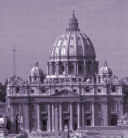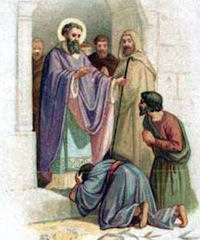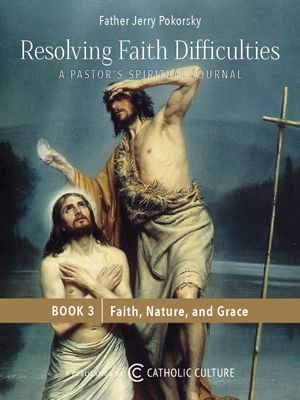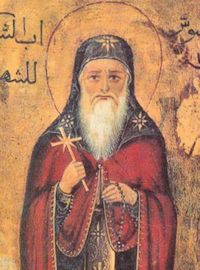Easter: May 9th
Thursday of the Sixth Week of Easter or Ascension Thursday
Other Commemorations: St. Pachomius, Abbot (RM)
» Enjoy our Liturgical Seasons series of e-books!
In the United States, the ecclesiastical provinces of Boston, Hartford, New York, Newark, Omaha, and Philadelphia have retained the celebration of the Solemnity of the Ascension on the proper Thursday while all other provinces have transferred this solemnity to the Seventh Sunday of Easter, May 12.
Today marks the beginning of the Pentecost Novena to the Holy Spirit, honoring the original novena (9 days of prayer) of the Apostles and Mary, awaiting the promised coming of the Paraclete. Catholic Culture has several versions to use. We also highly recommend this 10-Day Devotion to the Holy Spirit from the St. Josemaria Institute, taken from The Handbook of Prayers. The actual timespan between Ascension Thursday and Pentecost is 10 days, so you can choose a 9 or 10 day devotion. If you choose a 9-day devotion, end a day early or start Friday after Ascension Thursday.
The Roman Martyrology commemorates St. Pachomius of Tabenna (290-346), father of the cenobitical life, born near Esneh, Egypt; died at Phebôou c.346. After spending some time with the hermit Palemon, he withdrew to Tabennisi where he introduced community life among the hermits who gathered around him. Before he died he had established nine monasteries for men and two for women. His order continued until the 11th century. Represented in hermit's garb, or crossing the Nile on the back of a crocodile.
Meditation for Thursday of the Sixth Week of Easter or Ascension Thursday:
The Glorified Christ
1. On this day Christ's triumph is complete. The victory which He gained by His resurrection from the dead is today made perfect. The Lord, together with the human nature He assumed, has ascended to the Father. He now shares in the dominion of heaven and earth; He now rules all hearts and all souls.
2. Forty days have elapsed since Easter. During this period it was the intention of divine Providence that our faith in the resurrection of Christ should be confirmed and strengthened. The disciples had been bewildered by the fact that their Master had died on the cross. He had breathed forth His spirit, and His body had been buried. All this had weakened their faith and aroused doubts in the minds of the dejected disciples. During the forty days that followed, the apostles and disciples acquired such a firm and steadfast faith that they were not saddened by our Lord's ascension, but were rather filled with joy.
And indeed the Ascension was a cause for joy. Human nature had been exalted above the highest heavens and placed above the angels and archangels. It had been allowed to approach the very throne of God. The apostles knew now that they would be allowed to share in the glory of Him whose nature they shared.
Since the ascension of Christ is our exaltation, and whither the glory of the head has gone first, there the hope of the body is also called, let us rejoice with gladness and delight in giving thanks. For today not only have we been confirmed as the possessors of paradise, but in Christ we have even penetrated the heights of heaven, having gained far more through the ineffable grace of Christ than we had lost through the malice of the devil. For those whom the virulent enemy cast down from the happiness of their first state, these the Son of God has placed as one body with Himself at the right hand of the Father, who lives and reigns in the unity of the Holy Ghost for all eternity. Amen (St. Leo the Great).
3. Christ, our head, "hath raised us up together, and hath made us sit together in the heavenly places" (Eph. 2:6). We are "heirs indeed of God and joint heirs with Christ" (Rom. 8:17), called to share the inheritance of Christ. "Now you are the body of Christ, members of member" (I Cor. 12:27), "For no man ever hated his own flesh; but nourisheth and cherisheth it, as also Christ doth the Church" (Eph. 5:29). Now the members and the body share in that which belongs to the head. Thus we possess even today the riches and glory and exaltation of the ascension in Christ our head.
Christ's victory and triumph are not His personal victory and triumph, but belong to the whole Christ, to the entire Church, When He died on the cross He embodied the whole of mankind, and the whole of mankind shared in His death. As the second Adam, He includes the whole of mankind also in His resurrection and ascension. He won the victory and has triumphed, not only for Himself, but for us also, for the whole Church. Our head has been taken up into heaven, where He reserves a place also for us. That place already belongs to us and is secured for us by Christ. That does not mean that God will one day take us to Himself in heaven, but rather that God has already brought us to heaven in Christ.
"And if I shall go and prepare a place for you, I will come again and will take you to Myself, that where I am you also may be And whither I go you know, and the way you know" (John 14:3 f.).
How could we do anything else but rejoice, at least to the extent of our belief? Our joy as Christians on this occasion will be in direct proportion to our faith.
What must we do that we may be certain to share in the ascension later on? We need do only one thing, remain united to Christ. How can we remain united to Him? By becoming members of His body, His Church, and by living in harmony with its teachings.
—Benedict Bauer, O.S.B, from The Light of the World, Vol II
 Ascension Thursday
Ascension Thursday
Station with San Pietro in Vaticano (St. Peter's in the Vatican):
For the solemnity of the Ascension, we return again to St. Peter's in the Vatican. Here we join Peter and the other apostles watching Jesus ascend triumphantly into heaven. The Church acclaims Him in His holy humanity, invited to sit on the Father's right hand and to share His glory. But Christ's Ascension is the pledge of our own. Filled with an immense hope, the Church looks up towards her leader, who precedes her into the heavenly home and takes her with Him in His own person. The whole life of the Church is placed between our Lord's Ascension and His return on the last day. Confident that she does not wait in vain, she preaches His Gospel and spreads His grace everywhere until the day when He returns in all His Father's glory for those whom He came down to earth to snatch from Satan's power.
For more on San Pietro in Vaticano, see:
For further information on the Station Churches, see The Stational Church.
St. Pachomius
 St. Pachomius can justifiably be called the founder of cenobitic monasticism (monks who live in community). Even though St. Antony the Great was the first to go into the desert to live a life of seclusion pursuing evangelical perfection, he lived an eremitic life, that is, a primarily solitary life.
St. Pachomius can justifiably be called the founder of cenobitic monasticism (monks who live in community). Even though St. Antony the Great was the first to go into the desert to live a life of seclusion pursuing evangelical perfection, he lived an eremitic life, that is, a primarily solitary life.
Pachomius first started out as a hermit in the desert like many of the other men and women in the third and fourth centuries who sought the most radical expression of Christian life and he developed a very strong bond of friendship with the hermit Palemon. One day he had a vision during prayer in which he was called to build a monastery, and was told in the vision that many people who are eager to live an ascetic life in the desert, but are not inclined to the solitude of the hermit, will come and join him. His hermit friend Palemon helped him to build the monastery and Pachomius insisted that his cenobites were to aspire to the austerity of the hermits.
However, he knew that his idea was a radical one, in that most of the men who came to live in his monastery had only ever conceived of the eremitic lifestyle; his great accomplishment was to reconcile this desire for austere perfection with an openness to fulfilling the mundane requirements of community life as an expression of Christian love and service. He spent most of his first years as a cenobitic doing all the menial work on his own, knowing that his brother monks needed to be gently inducted into serving their brothers in the same manner. He therefore allowed them to devote all their time to spiritual exercises in those first years. At his death, there were eleven Pachomian monasteries, nine for men and two for women.
The rule that Pachomius drew up was said to have been dictated to him by an angel, and it is this rule that both St. Benedict in the west and St. Basil in the east drew upon to develop their better known rules of cenobitic life.
— Catholic News Agency
Highlights and Things to Do:
- Read more about St. Pachomius:
- St. Pachomius is considered to be the father of cenobitic monasticism. What does cenobitic even mean? The first type monastic living was the life of a hermit, living solitarily, called eremitic. Cenobitic monasticism emphasizes community life. In Western monasticism the cenobitic monks join in a community of a religious order, regulated by a religious rule, a collection of precepts. St. Augustine and St. Benedict followed the example set by Pachomius for their religious orders.








